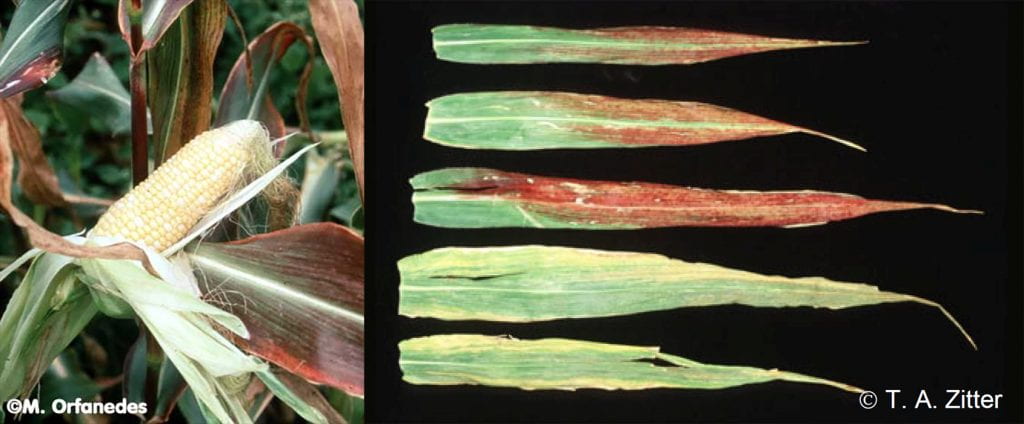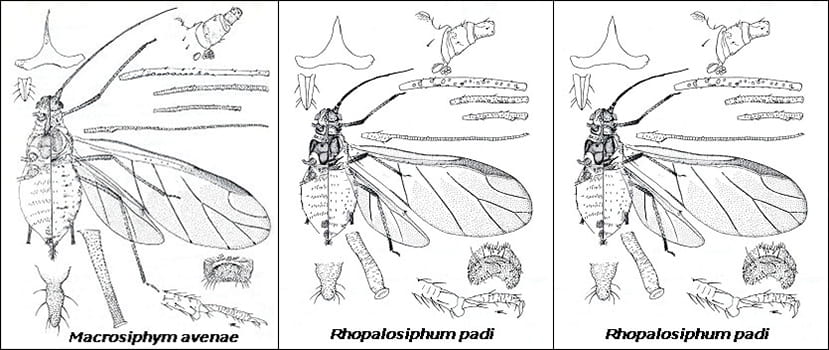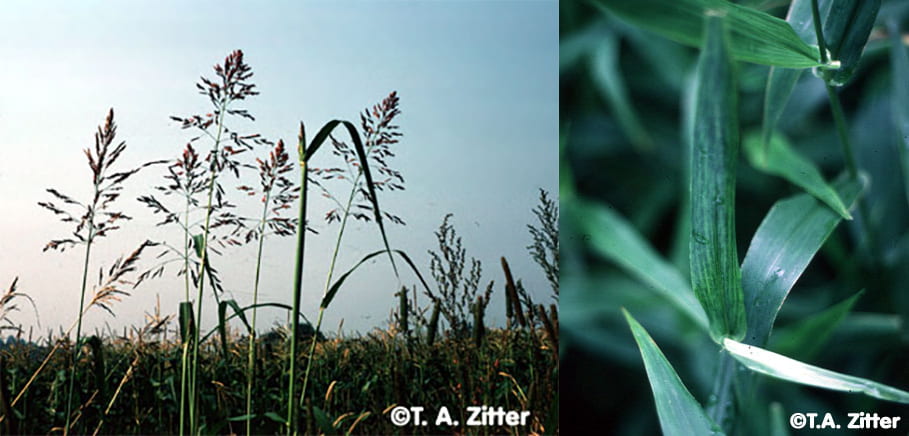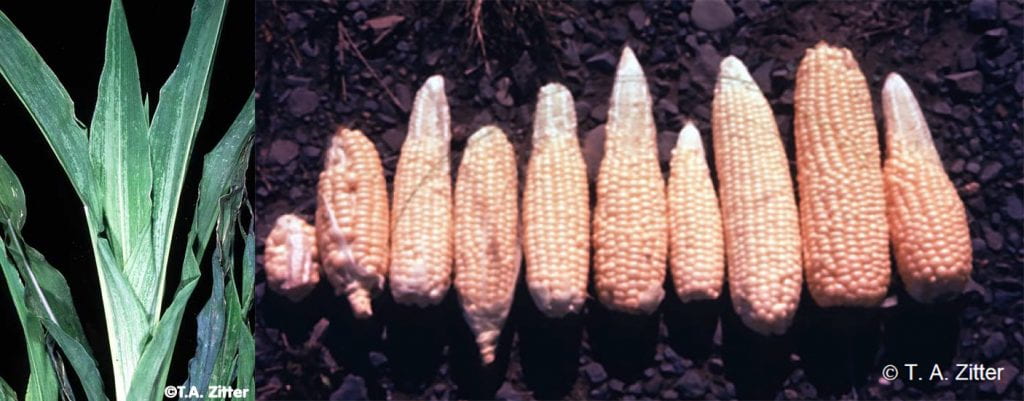Barley yellow dwarf virus (BYDV) is an aphid-vectored, viral disease which most typically strikes small grains, especially barley, oats, and wheat. Limited research has been conducted regarding its reaction in sweet corn because BYDV has not previously been an important concern. This changed during the 1998 season in New York when BYDV was epidemic in much of the western New York sweet corn crop. BYDV was again present during the 2000-growing season, and certainly was in part responsible for the erratic performance of the sweet corn crop. A second virus disease, noted to a lesser extent in 2000, was maize dwarf mosaic virus (MDMV). Both virus diseases are discussed below.
Barley yellow dwarf luteovirus (BYDV)
Virus description
BYDV is a phloem mobile, aphid-vectored virus commonly found in small grain crops and grassy cover crops. It is a persistently transmitted, circulative virus, unlike many other vegetable viruses which are nonpersistently transmitted by aphids. BYDV requires as much as 24-48 hours for acquisition to occur from deep within the phloem sap, to move through the aphid gut and into the salivary system, to replicate inside the aphid gut, and then to be transmitted back into the phloem of another susceptible host plant. BYDV may persist for weeks or even for life inside the aphid vector, meaning that transmission may occur over an extended period of time.
BYDV consists of several well-recognized strains. The complex relationship that exists between the aphid vector and the particular strain of BYDV and their serological properties, has separated BYDV into two groups: group 1 consisting of strains MAV, PAV and SGV, and group two consisting of RPV and RMV. Two strains of BYDV were confirmed in western New York sweet corn fields during the 1998 season — BYDV-PAV and BYDV-RMV. During the 2000 season, only the PAV strain was recovered based upon limited sampling. Both PAV and RMV are relatively asymptomatic in field corn. BYDV is not seed- or pollen-borne in corn or other graminaceous species.
Table 1. BYDV/CYDV were originally differentiated by their aphid vector species, but now the six viruses are distinguished by serotype-specific antibodies.
| Virus | Efficient vector | Luteoviridae genus |
| RPV | Rhopalosiphum padi (OB-CA) | Polerovirus (CYDV) |
| RMV | Rhopalosiphum maidis (CLA) instars | Not assigned |
| MAV | Sitobion avenae (Macrosiphum avenae) (EGA) | Luteovirus (BYDV) |
| SGV | Schizaphis graminum (Greenbug) instars | Not assigned |
| PAV | R. padi and S. avenae | Luteovirus (BYDV) |
| GPV (China) |
S. graminum and R. padi | Not assigned |
| Besides the oat bird-cherry aphid (OB-CA), the corn leaf aphid (CLA), the English grain aphid (EGA), and the greenbug, at least 20 additional species can vector BYDV or CYDV. | ||
Disease symptoms
The most prominent symptoms associated with BYDV-infected plants are purpling or yellowing along the leaf margins, running the length of both lower and upper leaves. The color involved depends upon the corn variety infected. The purpling symptom can mimic phosphate shortage, but this deficiency is most commonly observed on young plants. If plants are infected in an early stage, they may be stunted, and usually result in shorter ears, and blanking of the tip ends. See Fig. 1 and Fig. 2 below.

Aphid vectors
BYDV is vectored from infected small grains (winter wheat, oats, etc.) and certain graminaceous cover crops into both sweet corn and field corn by several species of aphids including the English grain aphid (Sitobion [Macrosiphum] avenae), the oat bird cherry aphid (Rhopalosiphum padi), and the corn leaf aphid (Rhopalosiphum maidis). Corn leaf aphids which are greenish blue and often have a waxy appearance, typically do not arrive in our area until mid-late June. However, the two grain aphid species may be present much earlier. The English grain aphid is relatively long and slender, light green to pink in color. In contrast, the oat bird cherry aphid is pear shaped and yellowish green to greenish brown. See Fig. 3 below.

Aphids establish themselves in sweet corn by flying in (as winged types) from nearby overwintering sites, neighboring crops, and areas to our south. Depending upon where they have been, these insects may or may not be carrying BYDV. If infected with BYDV, winged aphids can readily transmit the disease to sweet corn during feeding, a phenomenon known as primary spread. Subsequent generations of aphids are typically wingless colonizers and do not produce a winged generation unless crowding occurs or if environmental conditions become adverse.
Plants infected through primary spread serve as reservoirs of inoculum for further spread of the disease (secondary spread) either by wingless, colonizing generations or by a later winged generation. Mild winter weather favors overwintering survival of aphid vectors, however it is not known whether the bulk of infection originates from overwintering aphids or from migratory aphids moving in from points south.
Management guidelines
BYDV affects small grains every year in New York. What is not known is how abundant inoculum is in the previous fall’s seeded crops, the survival of overwintering vectors, and the influence of weather for the 2001 spring crops. These scenarios make it very difficult to predict the likelihood of a BYDV problem for this coming season. Here are some suggestions to reduce the risk of losses in 2001.
- Avoid planting sweet corn near maturing fields of small grains, grassy cover crops, and/or perennial grass weeds. In spring, plow cover crops under as soon as feasible and destroy nearby perennial grass weeds. Use good cultural practices and be sure to provide the sweet corn crop with adequate levels of nutrients and moisture.
- Because BYDV is a systemic and chronic disease, it is in the grower’s interest to keep the crop free of BYDV for as long as possible. Hence, insecticides applied to young corn may be more beneficial than those applied later on. Despite the fact that BYDV is a persistently vectored virus, insecticides will not be helpful in all situations. For example, insecticides cannot be relied upon to prevent primary introduction (spread) of BYDV in sweet corn. Case in point, if a high proportion of the early winged aphids moving into sweet corn are carrying BYDV, then significant primary infection will still likely occur, even if insecticides are used. This is because the aphids are already infectious when they enter the crop and are therefore capable of transmitting BYDV before any insecticide will kill them.
However, insecticides can be effective at reducing secondary spread, because of the time an uninfected aphid needs to acquire the virus, replicate it in its gut and transmit the disease to subsequent hosts. Hence, if a majority of the virus incidence is due to colonizing aphids moving the virus from a few early-infected plants, then insecticide applications that keep aphid populations low may reduce the incidence of disease.
When to spray and which insecticide(s) to use? Although soil insecticides can provide some control of corn flea beetles, none of the labels claim activity against aphids on sweet corn. Therefore, foliar insecticides appear to be the only option. Time sprays to coincide with the beginning of early season aphid migration and colonization in sweet corn. Historically, horizontally mounted, yellow-painted water pans have been used to monitor early aphid migrations into sweet corn crops. However, for most growers such tools would probably be difficult to install and maintain. Therefore, early season scouting of plants (beginning very soon after emergence) may be the most reasonable option. Initiate insecticide application(s) as soon as aphids can be found on the corn. Consult the sweet corn – corn leaf aphid section of Cornell Vegetable Guidelines for available insecticides.
Once the re-entry interval has passed after applying an insecticide, rescout the field to assess results and schedule any follow-up treatments that might be needed. Depending upon the infestation, several applications may be needed prior to the period when worm sprays are applied. With plastic corn, be particularly watchful during the first few weeks following plastic slitting or removal, as advanced, succulent corn may be especially attractive to aphids.
Maize dwarf mosaic potyvirus (MDMV)
Virus description — MDMV is a member of the potyvirus group, which represents the main vegetable-infecting group of viruses. The virus is transmitted in a nonpersistent (stylet-borne) manner by several aphid species. The virus is acquired in less than 60 sec., transmitted in less than 60 sec., but is not retained by the aphid for any length of time (usually less than 1 hr.). An aphid must revisit an already infected corn plant or a perennial grass reservoir to reacquire the virus.
MDMV had not been a factor for corn production in the state for 15 or more years before it was seen in 2000. Natural hosts have included field and sweet corn, grain sorghum, Johnsongrass (Fig. 4) (which is not important in New York), and various perennial weeds like deer’s-tongue (Panicum clandestinum) (Fig. 5), commonly found in the Hudson Valley. Interestingly, cultivated wheat, barley, oat and rye are not susceptible. Five strains of MDMV are recognized, with strain A considered as the type strain. MDMV strain B is now classified as a strain of sugarcane mosaic virus. MDMV is seed-transmitted in dent corn at very low frequencies (0.007 to 0.4%).

Disease symptoms
Systemic mosaic symptoms can appear on most varieties of sweet corn that do not carry tolerance derived from dent corn (Fig. 6). Like BYDV, the earlier the plant is infected, the more plant damage can occur. This consists of plant stunting, failure to set ears, and blanking of tip ends (Fig. 7).

Aphid vectors
At least 15 species can transmit MDMV, including the greenbug (Schizaphis graminum), the English grain aphid (Sitobion [Macrosiphum] avenae), the oat bird cherry aphid (Rhopalosiphum padi), and the corn leaf aphid (Rhopalosiphum maidis). Many factors can influence the frequency of transmission by aphids.
Management guidelines
MDMV occurred in at least three areas of the state in 2000 (Hudson Valley, Capital District, and western New York), but we can only speculate on reasons for its occurrence then. Movement of viruliferous aphids into corn has been previously noted, and with the heavy occurrence of common rust in 2000, air movement of rust and aphids is possible. The chance for seed transmission is very remote, and would not explain the occurrence over such a wide area, with such a wide divergence in variety selections. Although sweet corn varieties change frequently, we are unaware if some varieties are more susceptible than those grown in past seasons.
The management of MDMV is very difficult because of the nonpersistent manner of spread. Insecticides can reduce aphid populations, but do not prevent virus transmission, and at best would only slow the rate of virus spread.
Prepared by
Prepared in 2001 by Thomas Zitter for Vegetable MD Online. The barley yellow dwarf virus portion of this reported was adapted from a newsletter article prepared in March 1999 following the heavy occurrence of BYDV in 1998, and was authored by Orfanedes, Zitter, Straub, and Gray.
Updated March 2021 by Margaret T McGrath.


